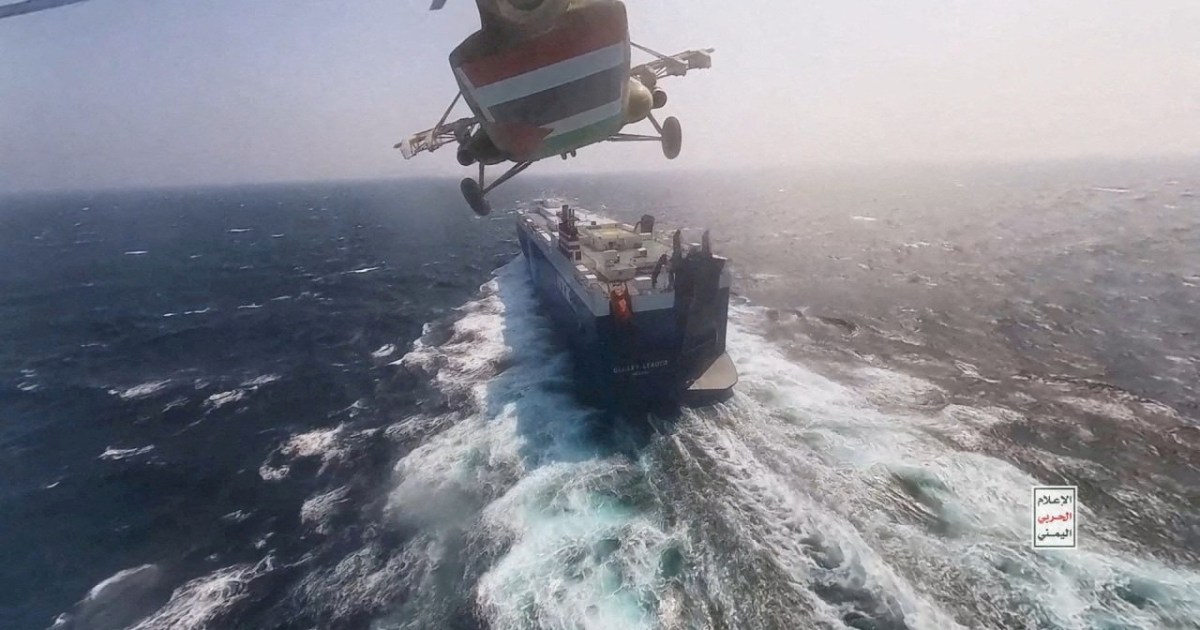
“In Yemen there is wisdom,” says a medieval Arabic proverb.
Keep that in mind if you want to figure out how the Israeli-Palestinian confrontation in Gaza is shaking the Middle East – because the ongoing Yemeni attacks on Israeli-linked ships in the Red Sea highlight one of the region’s most important political dynamics in recent times.
The rocket and drone attacks on Israeli ships or ships in recent weeks are a sign of support from Ansar Allah (Houthis), which controls most of northern Yemen, to the besieged Palestinians in Gaza. Ansar Allah said it would only stop these attacks when Israel ends its genocidal siege and bombardment of the Palestinian enclave.
These attacks are part of a coordinated military response by the three main Arab members of the Iran-led anti-Israel (and anti-Western) “Axis of Resistance,” Hezbollah, Hamas and Ansar Allah, to Israel’s latest attack on the Palestinians.
At one point last week, Israel and the United States were simultaneously engaged in a direct exchange of fire with Axis Resistance forces in both the Gaza Strip and the West Bank in Palestine, Lebanon, Syria, Iraq and also Yemen – also a strange low point can be viewed. Intensity, indirect military engagement with Iran.
Any assessment of how the region has evolved since October 7 and what likely lies ahead must take into account three critical points related to the regional network, military capabilities and the trajectory of the Axis of Resistance.
The mainstream media and US political elite tend to ignore all three points:
Groups within the Axis can coordinate across the region and confront Israel as a united front
Widespread fears in the West that this latest confrontation between Israel and Hamas would trigger a full-scale regional war between the United States, Israel and half a dozen Arab-Iranian forces have not materialized. However, the confrontation was not limited to Gaza – it triggered the first serious coordinated battlefield action by the Axis of Resistance in the entire region. This reflects Hezbollah’s year-round talk of “unity of fronts,” meaning that Axis members now coordinate and support each other in battle or between battles in times of preparation.
Ansar Allah can challenge Israel/US militarily to deter them or gain them concessions, just like Hezbollah and Hamas
For decades, Hezbollah and Hamas were the only two Arab powers to confront Israel militarily, forcing it to make ceasefires, prisoner swaps and other concessions. Ansar Allah’s ongoing drone and missile attacks on Red Sea shipping lanes are also likely to pose a challenge to Israel. These attacks could eventually give the Yemeni group important leverage against its Western opponents, especially if the United States and Israel, as expected, do not send ground troops to Yemen but rely solely on air power in their efforts to protect trade routes.
All three leading Arab members of the Axis of Resistance have significantly improved their military capabilities over the past two decades
Hezbollah was the first member of the Axis powers to demonstrate its military strength against Israel. The standoff between the Lebanon-based group and Israel in the 2006 war led to an informal ceasefire based on mutual deterrence. Both parties understood that full-scale war would cause severe damage to national assets and result in unacceptable levels of civilian casualties on both sides; Since then, they have limited their confrontations to limited attacks with limited casualties. On October 7, Hamas also demonstrated that it has built up significant military capabilities by launching an attack on Israel on an unprecedented scale and then defending its previous strengths. Ansar Allah’s capabilities are also improving – after forcing Saudi Arabia and the United Arab Emirates to end their war on Yemen, they attacked at least 100 ships in the Red Sea with high efficiency last month. A senior U.S. military official called this a “very significant range of attacks” that had not been seen in at least “two generations.”
We cannot yet predict what this means for the future, but this much is clear: Hamas’s new capabilities to attack Israel and defend its own assets bring it close to Hezbollah’s qualitative capabilities; and Ansar Allah’s proven proficiency in drone and missile strikes against Saudi Arabia, the United Arab Emirates and Red Sea shipping increases its military prowess.
The emerging reality is that the axis of resistance uniting Iran with half a dozen large and small Arab non-state armed actors is growing stronger and is likely to continue to do so if the issues driving the partnership remain unresolved – particularly Palestine conflict and Israeli-American aggression, threats or sanctions against Arab parties. Former American diplomat in Yemen, Dr. Nabeel Khoury, now a senior fellow at the Arab Center Washington, also told me in an interview that with the end of the war in Yemen, Ansar Allah now appears ready to act on a regional level.
However, you wouldn’t know this if your knowledge of the region comes from the mainstream US media. Because the American media largely follows the American political elite, and both tend to ignore the realities in the Middle East, which do not correspond to the Western prejudices of “weak” Arabs who only respond to the use of force by “righteous” Israeli- American armies are responding – although recent events in Palestine, Lebanon and Yemen have finally destroyed such racist visions.
The increasing power, integration and influence of the Axis of Resistance are among the most significant geostrategic developments in the Middle East in the last half century.
The combination of state-based Arab militancy from Hezbollah (Lebanon), Hamas (Palestine), and Ansar Allah (Yemen), as well as Iranian resistance to American and Israeli provocations, is best understood through their shared core values of “resistance” and “defiance.” The American media and political class, as well as most of the West, still refuse to see or acknowledge this because Israel, the US and their Arab allies are the ones being resisted and opposed. They prefer to judge developments in the region through their imaginary prism of Islamist extremism, which is blindly anti-American and anti-Israel. And they assume that they can overcome any challenge in the Middle East through Israeli-American military attacks, sanctions or threats.
It is not surprising, as scholars regularly confirm, that the US and Western media tend to report on Gaza in distorted frames, usually reflecting Israeli and US policies. Therefore, we should expect them to also report on Yemen and the expanding Axis of Resistance, largely due to Western and Israeli fears of growing Iranian influence. These include recent moves to send an American armada to the region and establish a 10-country task force to conduct joint patrols and provide intelligence in the Red Sea, the Bab al-Mandeb Strait and the Gulf of Aden . The aim is to keep maritime traffic running, although world-leading shipping companies such as Denmark’s AP Moller-Maersk and Germany’s Hapag-Lloyd have already diverted their ships to other routes.
Washington is also actively considering military strikes against Ansar Allah, although the axis of resistance and Yemeni history – consistent with its defiance – suggest this would not deter future attacks on ships.
The views expressed in this article are the author’s own and do not necessarily reflect the editorial stance of Al Jazeera.






Recent Comments